🎮 Witching Stone
2024年 5月 30日
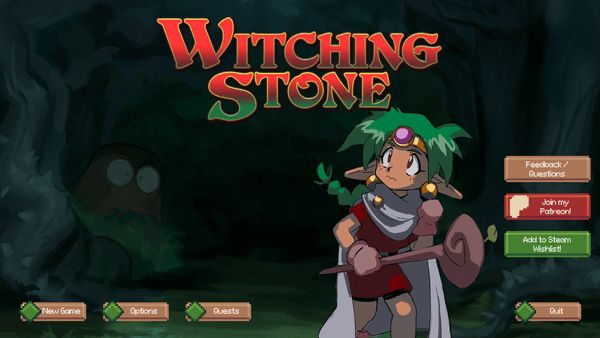
Do you ever see a game that you think, “Oh, that ticks all of my boxes. I need to get this in my life right away.” That was me laying eyes on Witching Stone by Alexander Taylor. I followed him on cohost where he puts his progress updates, and with each new post I fell more and more in love with this gorgeous turn-based roguelike. I finally got a chance to play it at January’s Tokyo Game Dungeon, and since then have been snapping up each new update of the demo on itch.
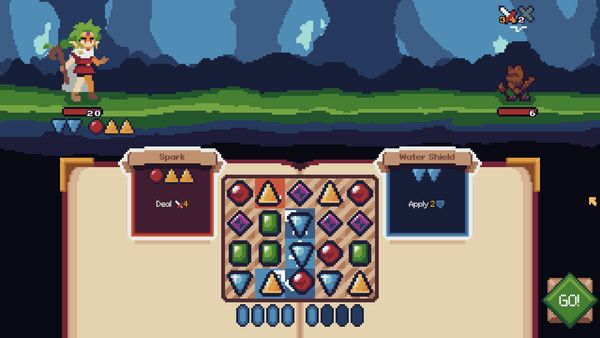
Witching Stone uses a unique puzzle grid for its battles where you draw a line through the different colored stones to cast spells.
Witching Stone is a turn-based roguelike deck-building game that swaps out the genre’s usual hand of cards with a unique puzzle board filled with colored stones. The idea is to activate abilities in battle by connecting stones on the board, in a way that feels more akin to puzzle games. I found such a delectable amount of customization under the hood that I feel like I’ve only just begun to scratch the surface of even the demo, let alone whatever ends up being in the full game.
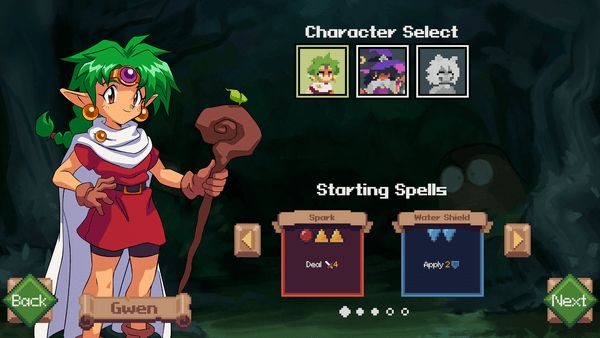
The character artwork is large and colorful, and looks like something straight out of a '90s anime.
You start the game with Gwen, the chipper green-haired witch. The game drops you into a map with random encounters, with helpful tutorials and tips that pop up to explain what the various symbols are. You will likely start your first battle against an easy green-level enemy. Much like in the genre-defining Slay the Spire, battles are turn-based with enemies telegraphing what actions they will take once you finish your turn. With Gwen, the idea is block when enemies plan to do damage, and press your attack whenever you can. Even though your options are quite limited for these early battles, it’s more than enough to get a feel for the rhythm of fights.
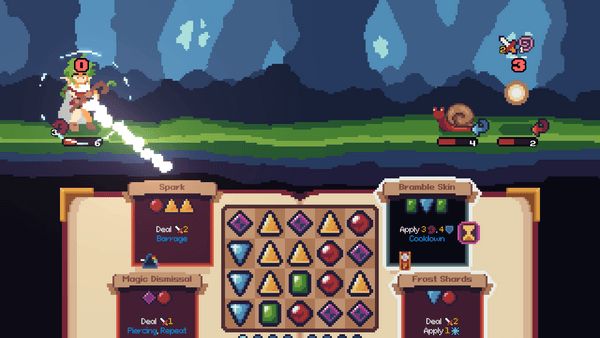
Take note of what your enemies are planning to do so you can prepare your shield in advance to soften the blow of their attacks.
The stone-connecting mechanic is both intuitive and quick, yet requires some forward-thinking since you will want to have the right stones in place for your next turn. As an example, neither of your starting skills require the green rectangles or purple diamonds, so if you have additional mana (the resource needed to connect stones), it might be worthwhile to clear some of these unnecessary pieces from the board to allow better stones to fall down and allow for more route options in the future.
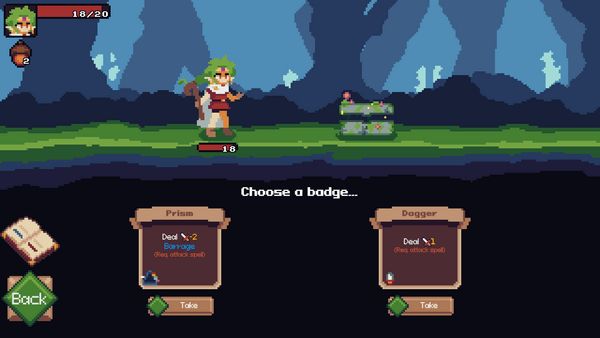
You can further customize your loadout by adding badges to your skill cards, adding new modifiers to your existing attacks.
Once you’ve gotten through a couple of the first fights, you’re probably itching to upgrade your setup. And here is where Witching Stone pulls out all the stops, even for what is supposed to just be a simple demo! You can collect more skill cards for a max of four. You can collect badges, which are modifiers that you can attach to your skill cards. The Absorb badge lets you heal a small amount when casting the spell it’s attached to; Barrage weakens your attack but has it hit the entire enemy party; the Old Shield adds an extra point of defense. It is so satisfying to mix-n-match your skills badges to create the most efficient way of taking on battles. And you are definitely going to need to do this, because once the green-level fights are done, the difficulty ramps up for the remaining battles, culminating in the level boss and final encounter of the demo.
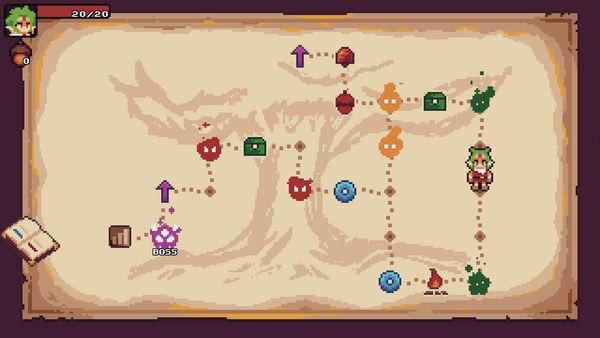
Clearing a path towards safe points like campfires and chests will let you prepare better before taking on tougher enemies.
With new skill cards come new stone patterns to pick out on the grid. You will rarely have enough mana or the right grid layout to activate all four skills every turn, so you will have to prioritize which ones to use, which blocks you will need to clear, and how much incoming you are willing to tank. The enemies also get more complicated moves, throwing special effects onto the stone board, such as Jammer stones that none of your skills use, to burning stones that cause damage if you chain through them. Battles can get very thorny very quickly, so you are going to want to think of contingency plans for when your main strategy just isn’t coming together.
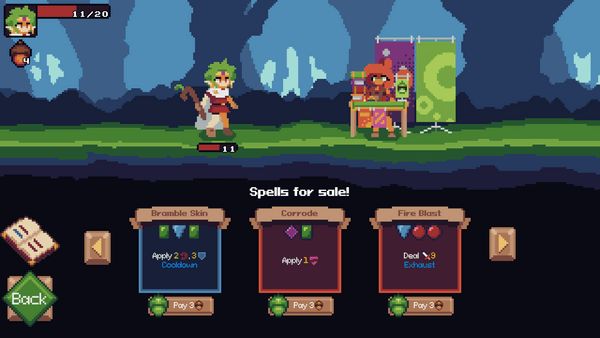
This still image does not do the shops justice. You really need to see the animation of this merch booth unfolding out of thin air.
Around the map, you can also find shops where you can give your acorns to a shape-shifting squirrel who runs a merch booth, complete with unfurling posters and folding table. (I cannot stress enough how great the animation for this looks. When I first saw it, I gasped. It was perfection.) There are also Blessing statues that bestow permanent stat boosts, such as increasing your max HP or spell book capacity. And finally, there are the usual treasure chests with goodies and resting spots to recoup health. You will have to pick and plan your battles carefully to create pathways to the resources before taking on the yellow- or red-level fights. I was a big fan of Dicey Dungeons handling its maps in a similar way, and loved the implementation here as well.
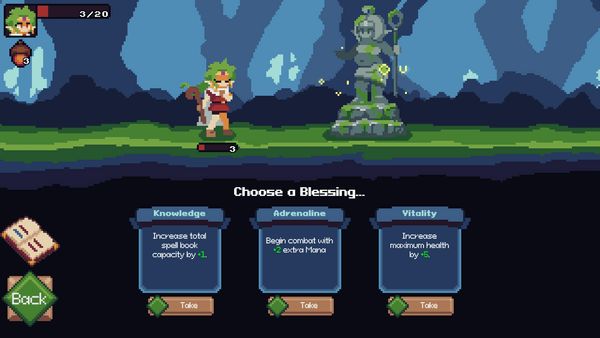
You can also gain Blessings, permanent stat buffs to further customize your play style.
The presentation is also incredible, with gorgeous sprite art and great animated touches like the aforementioned squirrel-run convention booth. Witching Stone uses particle effects tastefully to create a sense of magic with each spell cast, and the many in-game icons are clear and easy to read. For colorblind players, the stones have distinct shapes along with their colors, and the skill cards clearly show which symbols you need to cast your spells. It’s clear that a ton of attention went into every detail to make the game as welcoming as it is deep.
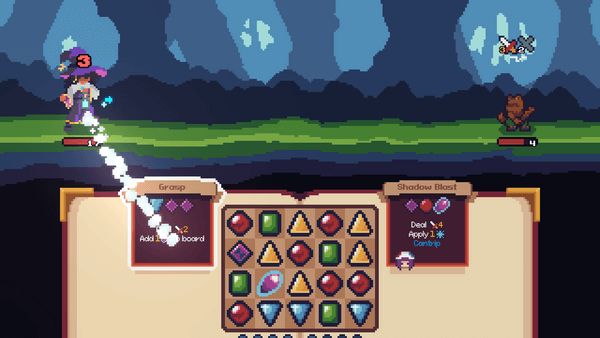
Once you've beaten the demo as Gwen, you can play as Ceridwen, the mysterious witch whose specialty is adding a unique new stone type to the grid.
Once you’ve cleared the demo as Gwen, you can unlock even more stuff. You can now play as Ceridwen, who swaps out Gwen’s Water Shield for spells that allow you to add special healing stones to the board. You can also choose from a random set of starting modifiers such as auto-clearing easy fights to automatically get their rewards but take a health penalty, or simpler ones like adding an extra badge slot to your spells. There is so many ways to challenge yourself in repeat plays that I almost want to take Alex to the side. You need to save some of this stuff for the full game!
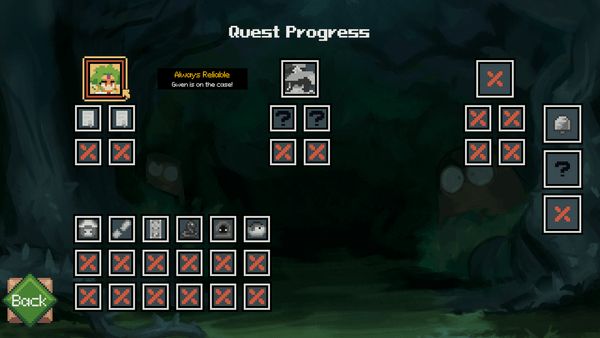
Can you believe this is only the demo? There is just way too much stuff to do!
Speaking of which, the full game is scheduled to come out later this year on Steam and itch. I don’t know if you could tell, but Witching Stone and games like it are extremely my jam, so this has been on my wishlist pretty much as soon as I laid eyes on it. I love getting sucked deep into the many layered mechanics of deck-builders, and cannot get over how intuitive the stone-connecting mechanic feels to play. If you haven’t tried it yet, you owe it to yourself to at least check out the demo and fall deep under the spell of Witching Stone!
